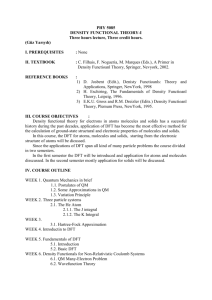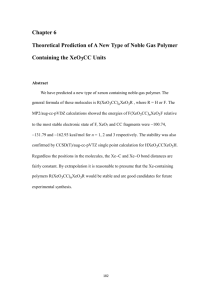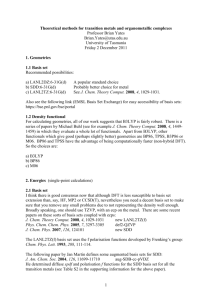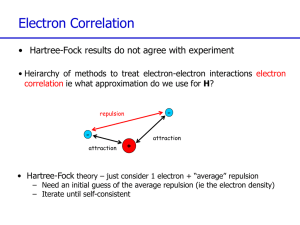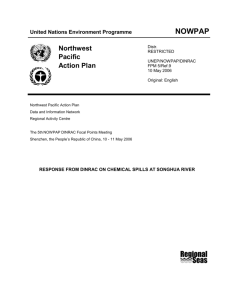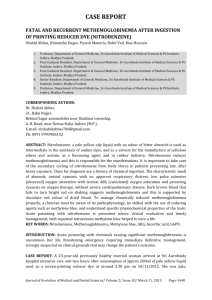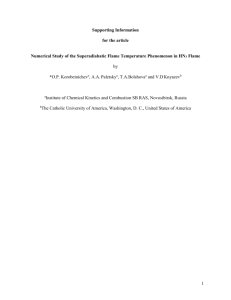supplemental_sept_25 2013
advertisement
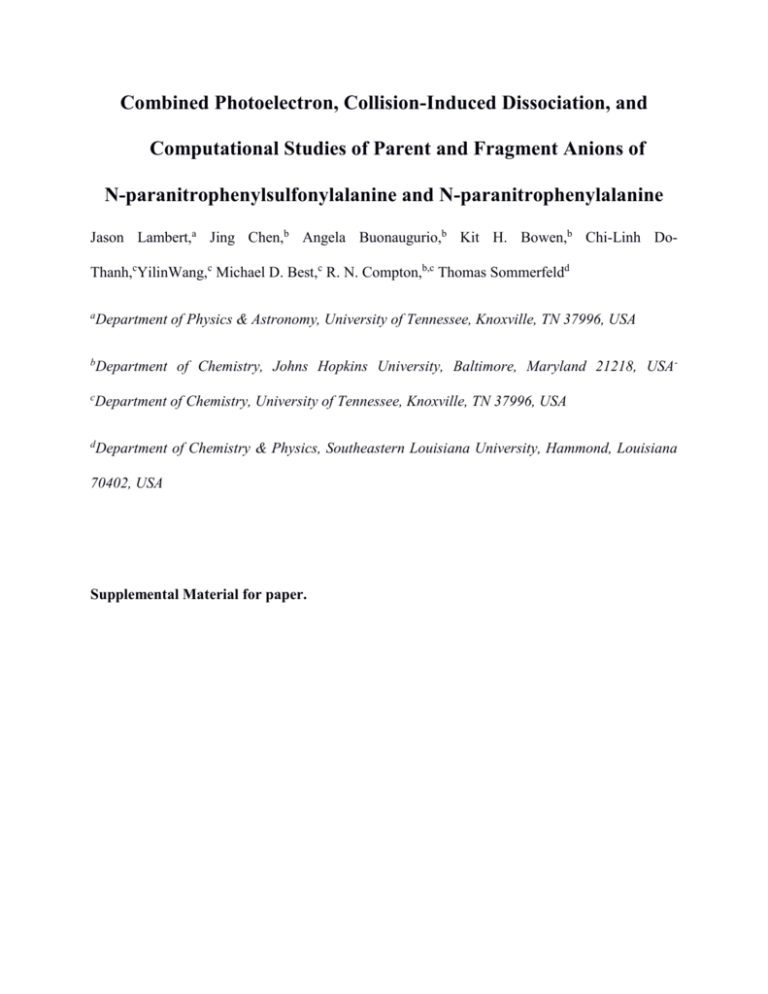
Combined Photoelectron, Collision-Induced Dissociation, and Computational Studies of Parent and Fragment Anions of N-paranitrophenylsulfonylalanine and N-paranitrophenylalanine Jason Lambert,a Jing Chen,b Angela Buonaugurio,b Kit H. Bowen,b Chi-Linh DoThanh,cYilinWang,c Michael D. Best,c R. N. Compton,b,c Thomas Sommerfeldd a Department of Physics & Astronomy, University of Tennessee, Knoxville, TN 37996, USA b Department of Chemistry, Johns Hopkins University, Baltimore, Maryland 21218, USA- c Department of Chemistry, University of Tennessee, Knoxville, TN 37996, USA d Department of Chemistry & Physics, Southeastern Louisiana University, Hammond, Louisiana 70402, USA Supplemental Material for paper. 1. Methods for computing the AEA, VDE, and VEA associated with the 2B1 valence state of the nitrobenzene anion Nitrobenzene is a useful reference system for NPNPSA and NPNPA, because both of the larger molecules form analogous valence anion states where the excess electron is essentially localized on the nitrobenzene moiety. Moreover, the experimental AEA of nitrobenzene of 1.00 eV,1 is well known. However, the experimental result includes zero-point effects and for validation purposes, the AEA value without corrections is more useful. To obtain a zero-pointeffect-free “experimental” value, the zero-point correction of the AEA of nitrobenzene was computed using three density functionals, M06-2X, B3LYP, and TPSS, with the aug-cc-pVDZ basis set. The three functionals agreed with each other reasonably well and yielded corrections of 84, 71, and 73 meV, respectively. Therefore, the experimental value for the purely electronic AEA of nitrobenzene should be close to 0.92 eV, and this is the value we will subsequently compare with. The first set of methods considered is the usual sequence of ab initio methods, SCF, MP2 and coupled-cluster based methods. Unfortunately, the UHF wavefunction for the anion shows a large spin-contamination, so that neither SCF nor MP2 are expected to yield useful results, which is indeed the case (see Table S1). Coupled cluster calculations are known to be able to recover from spin contamination in the reference wavefunction, and UHF-based CCSD(T) calculations do yield results much more reasonable than UHF or UHF-based MP2. Yet, CCSD(T) calculations started from a ROHF reference, or from a reference constructed using the orbitals of the neutral (QRHF) yield virtually identical results, which are quite a bit higher than the UHF based coupled-cluster results (~70 meV) suggesting that in this case recovery from spin-contamination is not complete. Another test is direct computation of the electron affinity with the EOM-CCSD method, which gives results in close agreement with ROHF-based CCSD(T). Regarding basis sets effects, the coupled cluster values follow the usual trend that the experimental value is approached from below reflecting that there is more electron correlation in the anion than there is in the neutral. With the aug-cc-pVDZ basis set the result is about 0.1 eV too low, with the aug-cc-pVTZ set this difference is down to less than 50 meV, and thus the CCSD(T) calculations clearly approach the “experimental” value of 0.92 eV is a systematic manner. Based on this finding, the ROHF-based CCSD(T) and EOM-CCSD values for the VDE and VEA are also expected to represent good guidelines for the validation of density functional methods. Eight different density functionals were used to compute the VEA, VDE, and AEA of nitrobenzene, the M06-2X, B3LYP, and O3LYP hybrid functionals, the less expensive metaGGA functional TPSS, and the GGA functionals BLYP, BP86, PBE, and OLYP. All functionals systematically over-bind the electron with the most recently developed functional used, M06-2X, doing in fact the worst job at predicting the respective detachment and attachment energies. All density functional methods show the trend that the experimental value is approached from above as the basis set is expanded, and even with the aug-cc-pVTZ set, most functionals over-bind by more than 0.1 eV. The exception is the OLYP GGA, which yields AEAs in perfect agreement with the experimental AEA if the aug-cc-pVTZ basis set is used. The situation is worse for the VDE and even more so for the VAE. The formerly more reliable hybrid functionals tend to overbind by 0.3 eV or more, while the GGAs do not show a clear trend. In particular OLYP, and to some extend the BLYP and TPSS functionals, perform significantly better than the hybrid functionals, a trend that has been noticed before but even those two functionals significantly overestimate the VAE of the 2B1 state. Since density functional results tend to be less dependent on diffuse functions than ab initio methods and this is in particular true for GGAs, a triple-z set augmented with a diffuse spset on the heavy atoms and a single diffuse s function on H was considered.44 Indeed using Ahlrich's Def2-TZVP (ma-Def2-TZVP) set with this minimal augmentation yields results in very close agreement with the aug-cc-pVTZ results for both the OLYP and TPSS functionals. In conclusion, CCSD(T) or EOM-CCSD are as expected needed to compute reliable electron binding energies, yet, for systems larger than nitrobenzene these methods are not practicable even with the “minimal” aug-cc-pVDZ set. In the nitrobenzene case ΔMP2 is not an alternative, because of the large spin-contamination in the unrestricted SCF calculation for the anion, and the only alternative are density functional based methods. Regarding the geometry optimizations, hybrid functionals such as B3LYP, or better M06-2X, are anyway expected to be the best tradeoff between reliability and computational cost. However, our results show that these functionals are not the best choice for computing electron attachment energies, but that the OLYP GGA functional, and to some extend the TPSS and BLYP functional yields results in better agreement with CCSD(T) and experiment. Based on our results one may expect that for systems similar to nitrobenzene AEAs of will be well reproduced if triple- basis sets are employed, while VDEs and VEAs are expected to be overestimated by a few tenth on an eV. Table S1. Ab initio and DFT calculations for the EBEs (in eV) of the 2B1 valence state of nitrobenzene. SCF MP2 UHFCCSD UHFCCSD(T) ROHFCCSD(T) ORHFCCSD(T) EOMCCSD M06-2x B3LYP O3LYP BLYP BP86 PBE OLYP TPSS AugpVDZ VAE 0.31 -0.81 VDE 1.33 -0.25 0.33 1.08 0.26 0.92 0.77 0.31 0.98 0.83 0.31 0.98 0.83 0.25 0.95 0.70 0.69 0.73 0.65 0.84 0.76 0.57 0.66 1.44 1.33 1.34 1.20 1.40 1.31 1.13 1.23 Aug-pVTZ AEA VAE VDE AEA 1.21 1.05 0.81 0.45 1.12 0.88 0.79 0.42 1.12 0.88 1.08 1.12 1.05 1.15 1.30 1.19 0.97 1.12 0.78 0.71 0.75 0.63 0.83 0.75 0.57 0.65 1.53 1.35 1.36 1.19 1.39 1.30 1.12 1.23 1.12 1.08 1.03 1.08 1.23 1.13 0.92 1.06 2. Methods for computing the VEA associated with the Dipole Bound state of the nitrobenzene anion Computing attachment energies associated with dipole-bound states is far more challenging than those with valence states. First, large sets of additional diffuse functions are needed, and saturating the basis set in this respect is critically important. Second, DFT methods cannot be used in the same straightforward way as for valence bound states. On the one hand, dipole-bound states are very diffuse, and therefore the long-range part of the functional must be free of electron self-interaction, so that the asymptotic electron-molecule interaction is correct. This is a principle problem, and uncorrected functionals such as B3LYP will give infinite binding energies in the complete basis set limit. On the other hand, there is the practical problem of choosing a suitable integration grid for Gaussian functions with very small exponents. In fact, in many programs it becomes practically impossible to reach convergence for the Kohn-Sham iterations, if three or four sets of progressively more diffuse functions are added to the basis set. Last, the attachment energies of dipole-bound states are very sensitive to long-range electron correlations effects, and reliable results often require CCSD(T) calculations with large valence basis sets.34 Nitrobenzene is to some extent a typical case. On an absolute scale the VEA of the dipole-bound state nitrobenzene is small, in the order of 15 meV, and Koopmans's Theorem as well as ΔSCF and ΔMP2 seem to be fairly close, but in relative terms the deviations are of cause significant. The often reliable, and more importantly robust direct methods EOM-MP2 and EOM-CCSD, overestimate the VEA making nitrobenzene a particular challenging case. For larger systems, such as NPNPSA or NPNPA, computing VEAs with CCSD(T) and triple-ζ quality basis sets is clearly out of question, and ΔMP2 seems to be the most promising tradeoff for larger system. Unfortunately, this tradeoff is partly spoiled by the presence of nearby valence states, which are easily separated by symmetry for nitrobenzene, but which cannot be separated for most conformers of NPNPSA or NPNPA. Table S2. Calculations for the VEAs (in meV) of the dipole-bound state of nitrobenzene. KT DSCF DMP2 DCCSD DCCSD(T) EOM-MP2 EOM-CCSD Aug-cc-pVDZ+6s6p5d 6.4 7.1 8.9 16.6 15.6 29.9 23.5 Aug-cc-pVTZ+6s6p5d 6.3 24.6 Table S3. Relative energies of conformers of neutral NPNPA. Minimal energy structures have been computed using M06-2X/aug-cc-pVDZ; the MP2/aug-cc-pVDZ energies have been evaluated at these geometries. All Cartesian coordinates are found in the supplementary data. Conformer (Neutral) 1 2 3 4 5 6 M06-2X Energy (kJ/mol) 0 36.9 10.9 28.5 41.3 16.8 MP2 Energy (kJ/mol) 0 30.6 2.7 22 36.6 9 Table S4. Relative energies of conformers of neutral NPNPSA. Minimal energy structures have been computed using M06-2X/aug-cc-pVDZ; the MP2/aug-cc-pVDZ energies have been evaluated at these geometries. All Cartesian coordinates are found in the supplementary data. Conformer (Neutral) 1 2 3 4 M06-2X Energy (kJ/mol) 21.6 0.0 13.1 9.3 MP2 Energy (kJ/mol) 19.8 0.0 13.2 9.1 Table S5. Relative energies of conformers of the NPNPA valence anion. The aug-cc-pVDZ basis set has been used. All Cartesian coordinates are found in the supplementary data. Conformer (Anion) 123456- M06-2X Energy (kJ/mol) 28.1 6.3 0 13.3 32.7 6.6 Table S6. Relative energies of conformers of the NPNPSA valence anion. The aug-cc-pVDZ basis set has been used. All Cartesian coordinates are found in the supplementary data. Conformer (Anion) 1234- M06-2X Energy (kJ/mol) 21.6 29.5 4.5 0.0 Table S7. Dipole moment of NPNPA conformers and VEA associated with NPNPA dipolebound states. The dipole moments have been computed using the M06-2X functional, and the VEA of the dipole-bound states has been computed at the M06-2X geometries, using KT, ΔSCF, and ΔMP2 with the aug-cc-pVDZ set further augmented with a 6s6p5s set centered at the center of mass of the molecule. VEA VEA VEA KT[meV] ΔSCF[meV] ΔMP2[meV] dipole moment Conformer [Debye] 1 7.6 20 22.6 36.5 2 2.9 2 2.4 11.2 3 7 54.2 67.3 106.6 4 8.5 58.6 70.4 111.5 5 8.5 58.7 68.6 103.1 6 6.9 65 84.4 141.3 Table S8. Calculated changes in Gibbs Free Energy (ΔG) and Enthalpy (ΔH) of NPNPSA-H with B3LYP/aug-cc-pVDZ, including vibrational corrections. Products 273→201+72 273→186+44+43 273→138+135 273→122+151 ΔG (eV) 1.52 -0.53 -1.06 3.20 ΔH (eV) 2.05 -1.57 -0.54 3.73 Table S9. Calculated changes in Gibbs Free Energy (ΔG) and Enthalpy (ΔH) of NPNPA-H with B3LYP/cug-cc-pVDZ, including vibrational corrections. Products 209 →165+44 209 →150+59 209 →123+42+44 209 →122+43+44 ΔG (eV) 1.43 4.21 1.53 1.95 ΔH (eV) 1.92 4.92 2.58 2.97 Figure S1. The CID spectrum of deprotonated NPNPSA. Figure S2. The CID spectrum of deprotonated NPNPA. Figure S3. Optimized structure of neutral 87 amu fragment for both NPNPA and NPNPSA. The CO2 was originally bound to the carbon bound to the nitrogen.
![[1] , ramegowda.rb [2] , phani konide](http://s3.studylib.net/store/data/007232622_1-484c205d524e137367bdbb76b981f60c-300x300.png)
